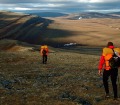A child’s feet are still developing and need the freedom to move and grow naturally. Unfortunately, most conventional shoes on the market restrict these movements, which some experts say can hinder a child’s walking.
Experts agree that most shoes are not optimal for the development of children’s feet as they restrict movement and impair natural foot development. Barefoot shoes could be the solution.
The Concept Behind Barefoot Shoes
Barefoot shoes are designed to support the natural foot structure of the child and allow for more natural movement, while protecting the feet from unnecessary pressure and strain.
In an interview with The Guardian, Tracy Byrne, a podiatrist specializing in podopaediatrics, explains that toddlers hold their heads up more when walking barefoot. This is because the sensory feedback from the ground reduces the need to constantly look down. This simultaneously reduces disturbances in balance and the risk of falls.
Byrne further explains that walking barefoot supports the development of muscles and ligaments, strengthens the foot arch, improves proprioception (our sense of position in space), and promotes good posture.
However, completely walking barefoot can be problematic, especially in urban areas with rough or dirty surfaces, which is where barefoot shoes come into play. These shoes, also known as minimalist shoes, offer a thinner, highly flexible sole and less arch support, allowing the feet to move more naturally.
Physical Benefits of Barefoot Shoes for Children
In addition to supporting proper foot development, barefoot shoes offer numerous physical benefits for children:
Improved Balance and Stability:
Many conventional shoes have excessive padding and a heel drop design, where the heel is higher than the toes. This disrupts a child’s natural walking pattern and makes balance and stability in movements more challenging.
Children’s barefoot shoes offer a thinner, more flexible sole and a wider toe box. This allows children to receive vital sensory feedback from the ground, improving their balance and coordination through more precise foot movements.
Enhanced Sensory Feedback:
Our feet are equipped with thousands of nerve endings that provide important sensory information to the brain. This helps us recognize different surfaces under our feet.
Wearing stiff shoes can dampen this feedback, as the thick padding and rigid soles absorb much of it. A study published in the Journal of Sports and Science Medicine found that individuals who wore barefoot shoes had better proprioception or body awareness than those who wore conventional shoes.
For toddlers learning to walk and run, enhanced sensory feedback is crucial for developing their motor skills and coordination.
Stronger Foot Muscles:
In addition to improved balance and sensory feedback, minimalist footwear strengthens the muscles in children’s feet and lower legs.
A study published in the Journal of Strength and Conditioning Research found that individuals who opted for minimalist shoes exhibited higher foot muscle strength than those who wore conventional shoes.
The researchers suggest that this increased strength is due to the greater demand on foot muscles to stabilize the body during movement.
Promoting Healthy Foot Mechanics:
Children’s feet are not fully developed until age 6; during this time, they are developing their natural gait pattern. Wearing conventional shoes with stiff soles or elevated heels can alter this process and lead to issues such as poor posture, back pain, and structural foot problems.
Barefoot shoes promote a natural gait, encouraging children to land on the ball of their foot and use their toes for gripping while walking and running.
Your child will be saved from developing common foot issues such as flat feet, pronation (where the heel bone angles inward), and supination (where it tilts outwards). This helps maintain their natural arch and promotes good posture.
Establishing Good Posture:
The zero-drop sole of barefoot shoes offers a flat sole, with the heel perfectly aligned to the ball of the foot. This keeps the body and skeletal system in proper alignment, with body weight evenly distributed throughout the feet.
In contrast, conventional shoes with a high heel-to-toe drop force the feet into an unnatural position, leading to increased stress on the back and neck and causing permanent postural changes over time.
Considerations When Choosing Barefoot Shoes for Children
A proper fit is essential to reap the full benefits of barefoot shoes for children. Here are some aspects to consider:
Ample Toe Space: The shoe should offer enough room for the child’s toes to spread out naturally and move comfortably.
Flexibility: Barefoot shoes should be flexible, allowing for a full range of motion in the foot. This helps maintain proper foot mechanics and strengthens the muscles.
Zero Drop: Look for shoes with no heel-to-toe drop, meaning the sole is flat. This allows for a more natural foot strike when walking or running.
Breathability: Choose shoes made from breathable materials such as leather or mesh to prevent fungal infections and keep the child’s feet dry.
Durability: Children are known to be hard on shoes, so opt for sturdy barefoot shoes with reinforced stitching and durable materials.
Lightweight: For added comfort, choose lightweight materials that do not weigh down on the child’s feet and allow for more natural movements.
Transitioning to Barefoot Shoes for Children
Slow and steady is key when transitioning your child to barefoot shoes. Here are some tips for a smooth and comfortable switch:
Start With Short Periods: Begin by having your child wear their barefoot shoes for short periods, such as 15-30 minutes, and gradually increase the duration over several weeks.
Allow Time for Adaptation: Wearing conventional shoes can weaken the muscles in the feet, and transitioning to barefoot shoes will require those muscles to work harder. Give your child’s feet enough time to adapt and strengthen.
Monitor for any Discomfort: If your child experiences discomfort, reduce the duration of wear until their feet adjust.
Choose Appropriate Activities: Start with less demanding activities such as walking and gradually introduce more challenging movements like running or playing sports.













